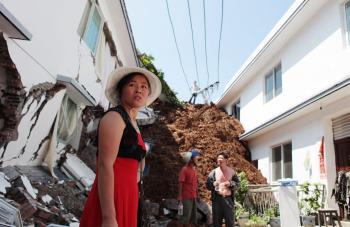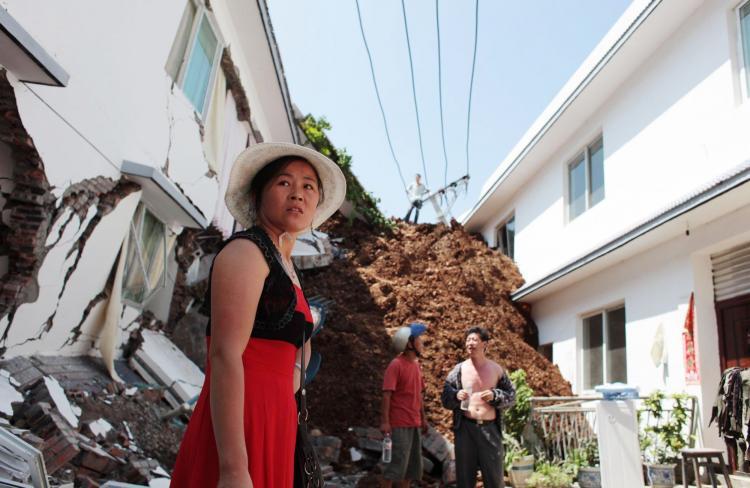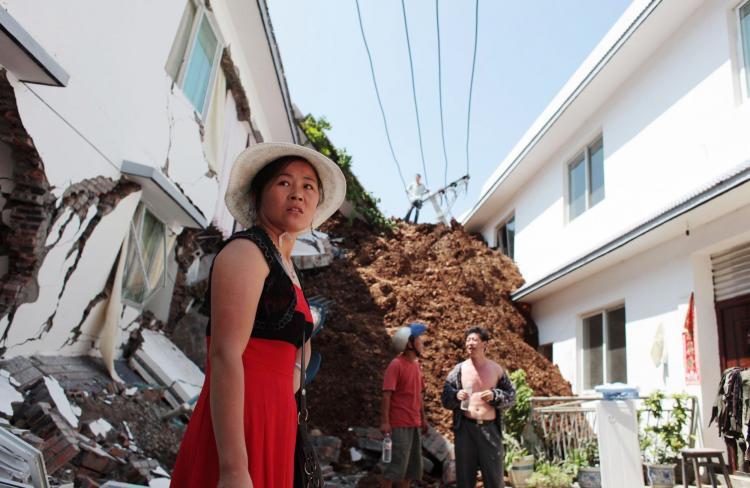What is expected to be the largest flooding in Chinese history struck the Yangtze River and the Three Gorges Dam on Wednesday, in the second test of the dam’s strength this month.
Since mid-July, the Yangtze and its tributaries have been inundated with water; at the flood’s peak 2.5 million cubic feet per second were passing through the dam, which sits across the Yangtze, outstripping the flooding of both 1954 and 1998, and setting a new record for floods in China.
Massive rains across China, in particular in the central-southern Chinese provinces of Sichuan and Hubei, have led to over 928 reported deaths and 477 people missing. Towns and villages have been flooded, and bridges swept away.
Separate floods have also wrought havoc in northern China. Most recently, about 30,000 people were trapped in Kouqian Town in the northeastern province of Jilin on Wednesday, after nearby reservoirs overflowed.
Sina.com, one of the largest news portals in China, reported dispatching journalists to investigate the conditions for locals in the cities along the Yangtze, including in Chongqing, Guangan, Yichang, Wuhan, and others.
The upper reaches of the river have suffered the most, whereas the middle and lower reaches, downstream of the Three Gorges Dam, have fared much better, according to their reporters. Up to 40 percent of the water, or 247 billion cubic feet, has been held back by the dam, according to Sina.
The expected rains were another test for the sturdiness of the Three Gorges, something the Taiwanese media, unhampered by censors, have been exploring for the last week.
Speaking during an interview on the freewheeling talk show “Guanjian Shike” (“Crucial Moment” or “It’s Time”), senior journalist Ma Hsi-Chin introduced the problem. “The holding capacity of the Three Gorges is roughly that of 200 Shimen Dams,” he said, referring to a reservoir in Taiwan’s south.
“If, by chance, the Three Gorges broke, that 200 Shimen Dams water quantity, those 39.3 million cubic meters [1.39 billion cubic feet] of water, let me tell you, even Shanghai would be swept into the sea!”
“Now, in the mainland, the whole of the Yangtze River is a ferocious dragon, the flooding is extremely, extremely severe. The most terrifying and startling point is right here: whether the Three Gorges will or won’t hold,” said Ma.
The reservoir behind the dam has a capacity of 594 feet. When the video of Ma’s discussion was aired, the water level was at 485 feet. That was around July 20 before the latest rains.
Discussion of collapse of the dam has largely been sanitized from domestic media in China. Official state mouthpiece Xinhua quotes citizens and officials expressing confidence in the staying power of the dam.
However, the seriousness with which Communist Party leaders are treating the issue was highlighted last week when the Three Gorges was put under pressure for the first time. The State Council Information Office (SCIO), also known as the Office of Foreign Propaganda, which reports directly to the Party’s top leaders, set up a website and staged a press conference meant to reassure the public about the dam’s robustness.
The Three Gorges Dam costs, including on the environmental, financial, and human fronts, have been enormous, and the calamity a collapse of the dam would bring is also almost unthinkable, according to the Taiwanese commentators who appeared with Mr. Ma.
Some 300 miles downstream in Wuhan, they face a more immediate problem than the Three Gorge’s potential collapse: a “pincer attack” from floods in both the Yangtze and Han rivers. The Han is a tributary connected to the Yangtze, meeting in Wuhan.
On July 28, the water reached 89.6 feet, and on July 29 reached 100 feet, according to Xinhua—only 3.5 inches below the capacity level.
For both rivers to flood is historically extremely rare. The height of the water and the duration of the flood are proving an enormous test for the authorities’ anti-flood measures. Xinhua’s has highlighted this with a section dedicated to the subject called “China Fights Against Floods 2010.”
Since mid-July, the Yangtze and its tributaries have been inundated with water; at the flood’s peak 2.5 million cubic feet per second were passing through the dam, which sits across the Yangtze, outstripping the flooding of both 1954 and 1998, and setting a new record for floods in China.
Massive rains across China, in particular in the central-southern Chinese provinces of Sichuan and Hubei, have led to over 928 reported deaths and 477 people missing. Towns and villages have been flooded, and bridges swept away.
Separate floods have also wrought havoc in northern China. Most recently, about 30,000 people were trapped in Kouqian Town in the northeastern province of Jilin on Wednesday, after nearby reservoirs overflowed.
Sina.com, one of the largest news portals in China, reported dispatching journalists to investigate the conditions for locals in the cities along the Yangtze, including in Chongqing, Guangan, Yichang, Wuhan, and others.
The upper reaches of the river have suffered the most, whereas the middle and lower reaches, downstream of the Three Gorges Dam, have fared much better, according to their reporters. Up to 40 percent of the water, or 247 billion cubic feet, has been held back by the dam, according to Sina.
A Second Test of the Yangtze
The expected rains were another test for the sturdiness of the Three Gorges, something the Taiwanese media, unhampered by censors, have been exploring for the last week.
Speaking during an interview on the freewheeling talk show “Guanjian Shike” (“Crucial Moment” or “It’s Time”), senior journalist Ma Hsi-Chin introduced the problem. “The holding capacity of the Three Gorges is roughly that of 200 Shimen Dams,” he said, referring to a reservoir in Taiwan’s south.
“If, by chance, the Three Gorges broke, that 200 Shimen Dams water quantity, those 39.3 million cubic meters [1.39 billion cubic feet] of water, let me tell you, even Shanghai would be swept into the sea!”
“Now, in the mainland, the whole of the Yangtze River is a ferocious dragon, the flooding is extremely, extremely severe. The most terrifying and startling point is right here: whether the Three Gorges will or won’t hold,” said Ma.
The reservoir behind the dam has a capacity of 594 feet. When the video of Ma’s discussion was aired, the water level was at 485 feet. That was around July 20 before the latest rains.
Discussion of collapse of the dam has largely been sanitized from domestic media in China. Official state mouthpiece Xinhua quotes citizens and officials expressing confidence in the staying power of the dam.
However, the seriousness with which Communist Party leaders are treating the issue was highlighted last week when the Three Gorges was put under pressure for the first time. The State Council Information Office (SCIO), also known as the Office of Foreign Propaganda, which reports directly to the Party’s top leaders, set up a website and staged a press conference meant to reassure the public about the dam’s robustness.
The Three Gorges Dam costs, including on the environmental, financial, and human fronts, have been enormous, and the calamity a collapse of the dam would bring is also almost unthinkable, according to the Taiwanese commentators who appeared with Mr. Ma.
Wuhan Beset on Two Fronts
Some 300 miles downstream in Wuhan, they face a more immediate problem than the Three Gorge’s potential collapse: a “pincer attack” from floods in both the Yangtze and Han rivers. The Han is a tributary connected to the Yangtze, meeting in Wuhan.
On July 28, the water reached 89.6 feet, and on July 29 reached 100 feet, according to Xinhua—only 3.5 inches below the capacity level.
For both rivers to flood is historically extremely rare. The height of the water and the duration of the flood are proving an enormous test for the authorities’ anti-flood measures. Xinhua’s has highlighted this with a section dedicated to the subject called “China Fights Against Floods 2010.”







